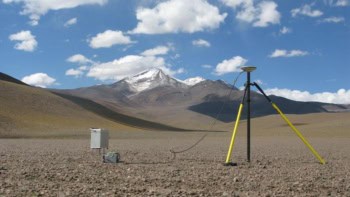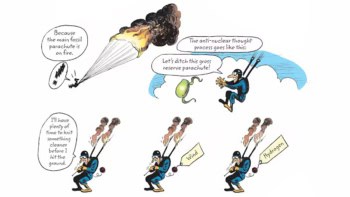
Elephant “rumbles” can be detected by seismic sensors after the low-frequency vocalizations have travelled more than 6 km through the ground – according to a team of geophysicist and biologists in the UK. The researchers say that the elephants likely use these ground vibrations – and those created by their movement – for long-range communication and information sharing. The scientists also suggest that networks of seismic sensors could be used to study elephants and also to monitor poaching by detecting elephants that run in panic.
Previous research has hinted that elephants monitor ground vibrations and use them to communicate, but the nature of these vibrations was not well understood. In the latest study, Beth Mortimer and colleagues at the University of Bristol and the University of Oxford, used seismic sensors called geophones to record ground-based vibrations from wild elephants in Kenya.
They discovered that different elephant behaviours create distinguishable seismic signatures. Perhaps unsurprisingly given their immense size, the ground vibrates when elephants move, but they also generate distinct ground-based vibrations through their rumbles. These are low-frequency vocalizations, usually under 20 Hz, that are below the audible range for humans.
The team also recorded natural and human generated seismic signals, such as car noise. Using seismic modelling techniques they then calculated how far elephant seismic vibrations can travel while still being detectable – taking into account different terrains and background noise levels.
Surprising forces
“We were surprised by the size of the forces acting on the ground that were generated by elephants when they vocalize,” says Mortimer. “We found that the forces generated through elephant calls were comparable to the forces generated by a fast elephant walk. This means that elephant calls can travel significant distances through the ground and, in favourable conditions, further than the distance that calls travel through the air.”
Rumbles of bull elephants were found to produce higher input forces than fast elephant walks, with maximum seismological forces of 2546 N versus 946 N respectively, and the resulting seismic waves were therefore able to travel much further. The maximum propagation range estimate for rumbles was 6.4 km, compared to 3.6 km for a fast elephant walk.
According to the researchers, the results suggest that elephants have the option of using seismic signals created by rumbles for long-range communication. They also say that long-range information transfer is possible from high-force movement. For example, rapid running is a sign of distress or aggression in elephants and the vibrations from such behaviour can travel long distances, potentially providing useful information to promote vigilance in other elephant groups.
Seismic recording could also provide biologists with a continuous, non-intrusive way to remotely monitor elephants and study their behaviour, the researchers claim. Oxford’s Tarje Nissen-Meyer told Physics World that the information available would depend on the nature of the seismic network.
“We estimate that rumbles as well as panic and run are discernible modes of behaviour,” he explains. “We can possibly also constrain the numbers of elephants in a herd by these means.”
Detection, localization and discrimination
Mortimer adds: “We will aim for detection, localization and discrimination – both of elephants from other wildlife and between elephant behaviours. This is likely to be in combination with other monitoring methods, as an extra source of information.”

Elephants turn to seismic communication
It might also be possible to use seismic sensors to develop a real-time alarm system that can detect elephants under threat from poachers, by picking up signals from elephant behaviours like panic running, the researchers say. Nissen-Meyer explains that while this research only suggests “that a quick determination of elephant panic behaviour can in principle be detected over considerably large distances”, the team is seeking financial support to further investigate the idea.
Christian Rutz, an evolutionary ecologist at the University of St Andrews, recently proposed the development of anti-poaching tags for large mammals that alert ground teams in real-time when animals come under attack, enabling rapid intervention. He says that he is intrigued by the idea of a seismic monitoring network for elephants. “I think the idea to use seismic detection to identify when elephants are being chased by poachers, or have been wounded and fallen over, is worth exploring,” he says.
The research is described in Current Biology.


